- Home
- Julian May
The Nonborn King
The Nonborn King Read online
Table of Contents
Title Page
Table of Contents
Copyright
Synopsis
Dedication
Epigraph
Prologue
PART I
1
2
3
4
5
6
7
8
9
10
11
12
13
PART II
1
2
3
4
5
6
7
8
9
10
11
12
13
PART III
1
2
3
4
5
6
7
8
9
PART IV
1
2
3
4
5
6
7
8
Epilogue
Appendixes
The Nonborn King Copyright © 1983 by Julian May
All rights reserved. No part of this work may be reproduced
or transmitted in any form or by any means, electronic or
mechanical, including photocopying and recording, or by
any information storage or retrieval system, except as
may be expressly permitted by the 1976 Copyright Act or
in writing from the publisher. Requests for permission should
be addressed in writing to Houghton Mifflin Company,
2 Park Street, Boston, Massachusetts 02108.
Printed in the United States of America
The verse quoted in the The Nonborn King on [>] is reprinted
with permission of Macmillan Publishing Co., Inc., from The Lion,
the Witch, and the Wardrobe, by C.S. Lewis. Copyright 1950 by
The Trustees of the Estate of C.S. Lewis, renewed 1978 by
Arthur Owen Barfield.
Maps by Richard Sanderson
Published by arrangement with
Houghton Mifflin Company
Two Park Street
Boston, Massachusetts 02107
Synopsis
The Galactic Milieu and the Pliocene Exile
THE GREAT INTERVENTION of 2013 opened humanity's way to the stare. By the year 2110, when the action of the first volume in this saga began, Earthlings were fully accepted members of a benevolent confederation of planet colonizers, the Coadunate Galactic Milieu, who shared high technology and the capability of performing advanced mental operations known as metafunctions. The latter—which include telepathy, psychokinesis, and many other powers—had lurked in the human gene pool from time immemorial, but only rarely were manifest.
The five founding races of the Milieu had observed humanity's development for tens of thousands of years. After some debate, they decided to admit Earthlings to the Milieu "in advance of their psychosocial maturation" because of the vast metapsychic potential of humanity, which might eventually exceed that of any other race. With the help of nonhumans, people from Earth colonized more than 700 new planets that had already been surveyed and found suitable.
Earthlings also learned how to speed the development of their metapsychic powers through special training and genetic engineering. However, even though the number of humans with operant metafunctions increased with each generation, in 2110 the majority of the population was still "normal"—that is, possessing metafunctions that were either meager to the point of nullity or else latent, unusable because of psychological barriers or other factors. Most of the day-to-day socioeconomic activities of the Human Polity of the Milieu were carried on by "normals"; but human metapsychics did occupy privileged positions in government, in the sciences, and in other areas where high mental powers were valuable to the Milieu as a whole.
At only one period between the Great Intervention and 2110 did it seem that the admission of humanity to the Milieu had been a mistake: This was in 2083, during the brief Metapsychic Rebellion. Instigated by a small group of Earth-based humans, this attempted coup narrowly missed destroying the entire Milieu organization. The Rebellion was suppressed by loyalist metapsychic humans and steps were taken to insure that such a disaster never would occur again. A certain number of battered rebel survivors did manage to evade retribution by passing through a unique kind of escape hatch, a one-way time-gate leading into Earth's Pliocene Epoch, six million years in the past.
The time-gate was discovered in 2034, during the heady years of the scientific knowledge-explosion subsequent to the Great Intervention. But since the time-warp opened only backward (anything attempting to return became six million years old and usually crumbled to dust), and since it had a fixed focus (a point in France's Rhône River Valley), its discoverer sadly concluded that it was a useless oddity without practical application.
After the time-gate discoverer's death in 2041, his widow, Angélique Guderian, learned that her husband had been mistaken.
***
The Intervention had seemed to open a Golden Age for humanity, giving it unlimited lebensraum, energy sufficiency, and membership in a splendid galaxy-wide civilization. But even Golden Ages have their misfits: in this case, humans who were temperamentally unsuited to the rather structured social environment of the Milieu. As Madame Guderian was to discover, there were fair numbers of these, and they were willing to pay handsomely to be transported to a simpler world without rules. Geologists and paleontologists knew that the Pliocene was an idyllic period, just before the dawn of rational life on our planet. Romantics and rugged individualists from almost all of Earth's ethnic groups eventually discovered Madame's "underground railroad" to the Pliocene, which operated out of a quaint French inn located outside the metropolitan center of Lyon.
From 2041 until 2106, the rejuvenated Madame Guderian transported clients from Old Earth to "Exile," a presumed natural paradise six million years younger. After suffering belated qualms of conscience about the fate of the time-travelers, Madame herself passed into the Pliocene and operation of her inn was taken over by the Milieu, which had found the time-warp to be a convenient glory hole for dissidents. By 2110, nearly 100,000 timefarers had vanished into an unknown destiny.
On 25 August 2110, eight persons, making up that week's "Group Green," were transported to Exile: Richard Voorhees, a grounded starship captain; Felice Landry, a disturbed eighteen-year-old athlete whose violent temperament and latent mind-powers had made her an outcast; Claude Majewski, a recently widowed elderly paleontologist; Sister Amerie Roccaro, a physician and burnt-out priest; Bryan Grenfell, an anthropologist following his lover, Mercy Lamballe, who had preceded him through the gate; Elizabeth Orme, a Grand Master metapsychic who had lost her stupendous mental powers after a brain trauma; Stein Oleson, a misfit planet-crust driller who dreamt of life in a simpler world; and Aiken Drum, an engaging young crook who, like Felice, possessed considerable latent metapsychic power.
Group Green discovered, as other time-travelers had before them, that idyllic Pliocene Europe was under the control of a group of maverick humanoids from another galaxy. The exotics were also exiled, having been driven from their home because of their barbarous battle-religion.
***
The dominant exotic faction, the Tanu, were tall and handsome. In spite of a thousand-year sojourn on Earth, there were still less than 20,000 of them because their reproduction was inhibited by solar radiation. Since their plasm was compatible with that of humanity, they had for nearly seventy years utilized the time-travelers in breeding, holding Pliocene humanity in benevolent
serfdom.
Antagonistic to the Tanu and outnumbering them by at least four to one were their ancient foes, the Firvulag. Often called the Little People, these exotics were mostly of short stature, although there were plenty of human-sized and even gigantic individuals among them. They reproduced quite well on Pliocene Earth.
Tanu and Firvulag actually constituted a dimorphic race—the former metapsychically latent, and the latter possessed of operant metafunctions, mostly limited in power. The Tanu, with their higher technology, had long ago developed mind-amplifiers, collars called golden tores, which raised their latent mind-powers up to operancy. Firvulag did not require tores to exercise their metafunctions. Certain of their great heroes were the mental equals of the Tanu in aggressive action, but most Firvulag were weaker.
For most of the thousand years that Tanu and Firvulag resided on Earth (which they called the Many-Colored Land), they were fairly evenly matched in the ritual wars fought as part of their battle-religion. The greater finesse and technology of the Tanu tended to counterbalance the superior numbers of the cruder Firvulag. But the advent of time-traveling humanity tipped the scales in favor of the taller exotics. Not only did Tanu-human hybrids turn out to have unusual physical and mental strength, but humans also enhanced the rather decadent science establishment of the Tanu by injecting the expertise of the greatly advanced Galactic Milieu. It had been strictly forbidden for time-travelers to carry sophisticated weaponry back to the Pliocene, and the Tanu were very conservative in the types of military hardware that they permitted their human slaves to build. Nevertheless, it was human ingenuity that eventually gave the Tanu almost complete ascendency over their Firvulag foes (who never mated with humans and generally despised them).
Most of the enslaved time-travelers actually lived a pretty good life under their Tanu overlords. All rough work was done by ramapithecines, small apes who wore simple tores compelling obedience and who were, ironically, part of the direct hominid line that would climax in Homo sapiens six million years in the future. Humans who occupied positions of trust or engaged in vital pursuits under the Tanu wore gray tores. These did not amplify the mind, but did allow telepathic communication with the Tanu, who were also able to administer punishment or reward through the device. If psychological testing showed that an arriving time-traveler possessed significant latent metafunctions, the lucky person was given a silver tore. This was a genuine amplifier similar to the golden collars worn by the exotic race, but having control circuits. Silver-torc humans were accepted as conditional citizens of the Many-Colored Land. Rarely, and only if they proved themselves, the silvers might be granted golden tores and full freedom.
The expanded tore technology, developed from the original golden devices worn by the Tanu, was the fruit of a single misfit genius—Eusebio Gomez-Nolan, a human psychobiologist who was eventually granted gold and who rose to become the President of the Coercer Guild, one of the five metapsychic quasi clans that formed the basis for Tanu society. Under the sobriquet of Lord Gomnol, Gomez-Nolan played a manipulative role in the power politics of the Many-Colored Land until he fatally overreached himself.
The overall destiny of both the Tanu and the Firvulag was subtly guided by a mysterious woman who belonged to neither race but served as guardian to both. This was Brede the Shipspouse. With her mate, the Ship, a gigantic rational organism capable of intergalactic travel, she had originally brought the exotics to Pliocene Earth. Brede could foresee the future—although not perfectly—and she came to know that the destinies of Tanu, Firvulag, and time-traveling humanity were inextricably united. A pivotal point in this joint destiny was reached with the arrival of the eight members of Group Green at the Tanu reception center, Castle Gateway.
***
It was Tanu custom to test all arriving time-travelers immediately for metapsychic latency. Latents, and those with unusual talents of other kinds, were sent south to the Tanu capital of Muriah, located on the Aven (Balearic) Peninsula in the nearly empty saline basin of the Mediterranean. Normal humans were shared out among the Tanu cities, taking their places in the working or (in the case of presentable women) breeding pools. Presorted caravans, escorted by gray-tore human troops, normally left Castle Gateway each week.
Group Green proved to be anything but typical when examined by the Tanu overseers in residence. Lord Creyn and Lady Epone.
Most notable was Elizabeth Orme. The trip through the time-gate had restored her to metapsychic operancy, a fact which Creyn was instantly aware of. Elizabeth's awesome powers of farsensing and redaction (mind-alteration) were convalescent; but when she recovered, it was evident that she would be far superior to any Tanu having those particular powers. Creyn predicted that a "wonderful life" lay ahead for Elizabeth in the Many-Colored Land. She herself was not so sure. The Milieu had expressly forbidden the time-travel of any operant metapsychics, since such persons would be in a position to exercise unfair mental domination over normal humans in a primitive environment that lacked the mental restraints of the Milieu's "Unity." Elizabeth was a totally nonaggressive personality as well as a self-centered one, and the only way she found to defend herself from what she regarded as a temptation to hubris was flight—either physical or mental.
A second member of Group Green, the recidivist youth Aiken Drum, was found to possess powerful latencies. He was collared with a silver tore and promised that if he behaved himself (a dubious prospect) he would enjoy special privileges after being trained in Muriah. Aiken's friend, the huge exdriller Stein Oleson, tried to escape from imprisonment in the castle, killing several guards with his Viking axe. Stein was subdued with a controlling gray tore and was earmarked, because of his heroic physique, to become a kind of gladiator in Muriah.
Richard Voorhees, the disgraced starship captain, also tried to escape. He stumbled into the chamber of the Tanu coercer Lady Epone, who brain-burned him and consigned him to a prison dormitory where other "normals" awaited the departure of the weekly caravan to Epone's city of Finiah, situated far northeast of the castle, on the River Rhine.
The anthropologist Bryan Grenfell had no metapsychic latencies, but Creyn was nevertheless impressed by his professional credentials. It seemed the Tanu had a certain urgent need for a cultural anthropologist! Bryan was also destined for Muriah and accepted the prospect with equanimity, since he expected to find his beloved Mercy Lamballe in the capital.
Claude Majewski, the old paleontologist, and the female priest Sister Amerie were tested and showed no latencies. But when Lady Epone attempted to test the girl Felice Landry, the little athlete seemed to go into hysterics. Her agitation made an accurate mental calibration impossible. Felice perpetrated this charade because she knew very well that she possessed very strong latent mind-powers; but she had no intention of being subjugated by a tore, especially after she discovered that both she and Sister Amerie were to be used as brood stock by the Tanu. In a private moment with the nun, Felice grimly resolved to "take" the entire Tanu race. Ludicrous though this vow of revenge seemed at the time, Sister Amerie felt no inclination to doubt Felice's ability to carry out her threat.
***
When caravans left Castle Gateway that evening, Group Green had been split in half. Bound northward for Finiah with a sizable group of normals were Felice, Sister Amerie, Claude, and the still groggy Richard. Six gray-tore soldiers and Lady Epone conducted the train, which rode horselike Pliocene beasts called chalikos. Also in this group were Basil, a mountain-climbing former don; Yoshimitsu and Tatsuji, who wore samurai garb reflecting their heritage; and one Dougal, who had been driven half-mad by the unwelcome attentions of Lady Epone.
The southbound caravan was much smaller. Led by Creyn with a minimal two-guard escort, it consisted of the untorced Elizabeth and Bryan, Aiken Drum in his silver collar, unconscious Stein wearing a gray tore, and two other latent humans who had been gifted with silver: Sukey Davies, a former juvenile officer from a colonial satellite, and Raimo Hakkinen, a glum Finno-Canadian forester.
/> The caravan heading for Muriah took ship at the River Rhône and made a fairly uneventful trip south. Creyn proved to be a tolerant overlord, deeply sympathetic to Elizabeth. Aiken Drum and Raimo became buddies and coconspirators, and Aiken discovered that the latencies inside his brain were unfolding at a wondrous pace that boded all kinds of fun and games. Stein recovered from wounds inflicted during the fracas at the castle, and he and Sukey pledged themselves to each other after she entered his mind and helped to heal a severe psychic trauma. In the riverside city of Darask, Elizabeth helped a human gold-torc woman, Estella-Sirone, give birth to twins—one Tanu and one Firvulag. And when the party eventually arrived in Muriah, they were greeted by a triumphal procession of magnificent Tanu chivalry, all clad in glowing, multicolored glass armor. The welcome was primarily for Elizabeth, who was soon to discover herself a pawn between several scheming factions at the Tanu court.
***
Meanwhile, on the trail north of Castle Gateway, the other four members of Group Green were plotting a prisoner revolt. Felice, a professional athlete, was abnormally strong, and her latent metapsychic powers enabled her to mind-control animals. She also had a small steel dagger, little more than a toy, which had been overlooked by searchers.
When the caravan reached a remote shore of the Lac de Bresse, Felice's plan for escape was put into action. Richard, disguised in Amerie's religious garb, surprised the head guard and stabbed him to death. Then Felice compelled the caravan's escorting pack of huge bear-dogs to attack Lady Epone and the other soldiers. In the ensuing fray, the samurai Tatsuji was killed, as well as the entire escort of gray troops. Richard approached Epone, thinking that she, too, was dead. But the exotic woman seized him with her powerful mind, in spite of the fact that she was nearly torn to pieces. Richard would have perished had he not stabbed her with Felice's little dagger.
(Much later, the nun, who was a physician, deduced that the nearly invulnerable Tanu were fatally poisoned by iron weapons. For this reason, they had proscribed the use of iron in Pliocene Europe, making do with copper alloys and a kind of supertough glass, vitredur, in its place.)

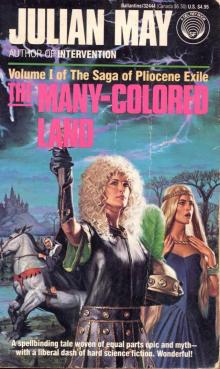 The Many-Coloured Land
The Many-Coloured Land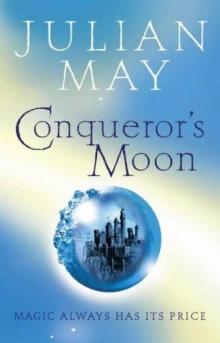 Conqueror's Moon
Conqueror's Moon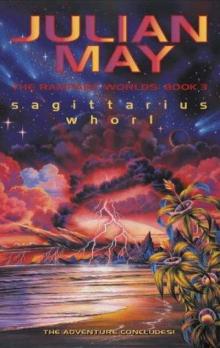 The Sagittarius Whorl
The Sagittarius Whorl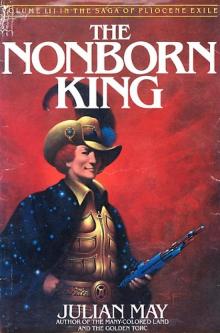 The Nonborn King
The Nonborn King Sky Trillium
Sky Trillium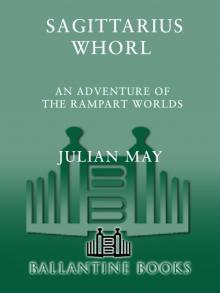 The Sagittarius Whorl: Book Three of the Rampart Worlds Trilogy
The Sagittarius Whorl: Book Three of the Rampart Worlds Trilogy Intervention
Intervention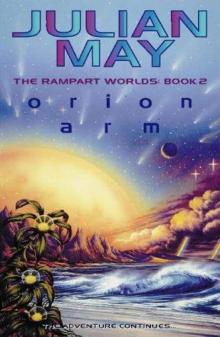 Orion Arm
Orion Arm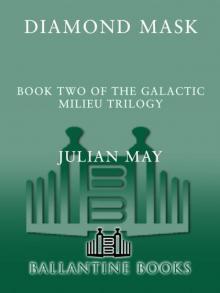 Diamond Mask
Diamond Mask The Golden Torc
The Golden Torc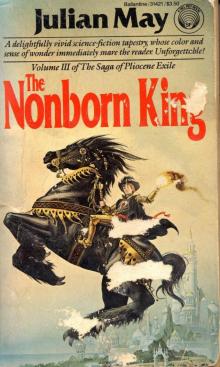 The Noborn King
The Noborn King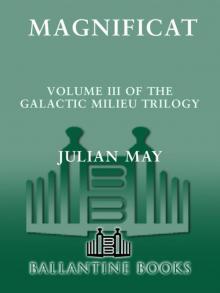 Magnificat
Magnificat Jack the Bodiless
Jack the Bodiless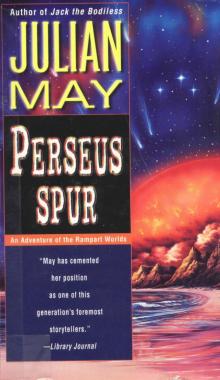 Perseus Spur
Perseus Spur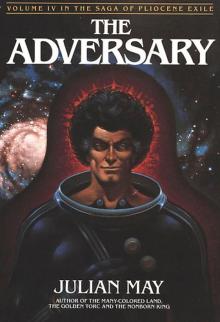 The Adversary
The Adversary Sorcerer's Moon
Sorcerer's Moon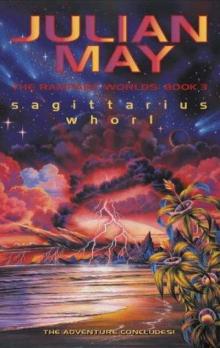 Sagittarius Whorl
Sagittarius Whorl The Intervention (Omnibus)
The Intervention (Omnibus)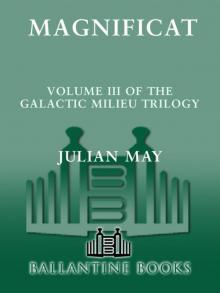 Magnificat (Galactic Milieu Trilogy)
Magnificat (Galactic Milieu Trilogy)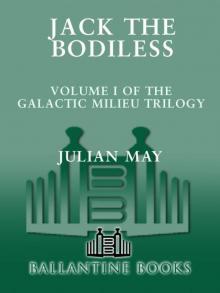 Jack the Bodiless (Galactic Milieu Trilogy)
Jack the Bodiless (Galactic Milieu Trilogy)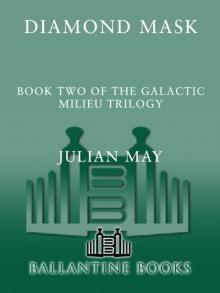 Diamond Mask (Galactic Milieu Trilogy)
Diamond Mask (Galactic Milieu Trilogy) The Many-Coloured Land sope-1
The Many-Coloured Land sope-1